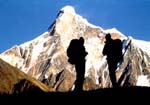


|
|
 |
| HOME | TRAVEL | TRAVELOG | ||

A Pilgrimage to the Famous Five ... the Panch Chulis Jaideep and Suniti Mukerji
Located in a remote corner of the Himalayas in India, close to the border with Tibet, stand five prominent snow peaks in a row rising more than 20,000 feet into the deep blue sky. Their profiles are perfectly triangular and, being symmetrical in shape and size, they look rather like a child's drawing of a mountain range. The peaks are called Panch Chuli by the villagers and shepherds who inhabit the densely forested valleys at its base -- in the local mountain dialect, Panch Chuli means the five hearths. These five peaks have been accorded meaning by Hindu legend as the five hearths on which the Pandavas -- principal characters of the Hindu epic Mahabharata -- cooked their last meal before ascending to heaven. The Himalayas, long considered sacred ground by the Hindus, was where the five brothers sought refuge after having lost their kingdom and their families to their warring cousins. This region, called Kumaon, is little known to people outside the region, perhaps having been visited by as few as half a dozen explorers in the last hundred years. The area was briefly explored by the British climber, Hugh Ruttledge, in 1927. And attempts were made to climb the peaks in 1950 by teams led by W H Murray and by Heinrich Harrer, author of Seven Years in Tibet, two years later. The lakshman rekha of the Inner Line permits -- issued by the Government of India, restricting travel to many mountain areas close to sensitive international borders -- effectively stopped further forays until one of the Panch Chuli peaks was finally climbed by an Indian Army team in 1973. In 1992, a team led by legendary mountaineer Chris Bonnington came close to disaster when Bonnington and another well known climber Stephen Venables were seriously injured in a fall on the mountain. The helicopter rescue was to go down in mountaineering lore as one of the most daredevil rescue efforts ever. Having considerable experience of walking and exploring the Himalayan regions since the 1970s, my interest was aroused when the restrictions were eased in 1994. To explore the thick forests of the lower slopes and the meadows and glaciers of the higher reaches of the Panch Chulis now seemed within reach.
However, even though official permission was now in hand, the mountains stayed tantalisingly out of view on that first visit. Unseasonal rains kept the Panch Chulis veiled from view for our entire stay; the narrow trails turned to slithery rivers of mud and our plans to get closer to the mountains finally cancelled when the chill rain turned to snow. We were an unhappy trio seeking some cheer with the local brew, rakshi, in a thatched roadside shack grandly called the Panch Chuli Bar when Pangtey, the local village headman, walked in. Introductions and a long discourse on the fickle local weather followed. We learnt that Munsiyari was one of the wettest places in the western Himalayas because of its unique topography. The following day, we were invited to Pangtey's house, reached by climbing a very narrow and nearly vertical ladder, to be introduced to his wife who sat behind a loom weaving a colourful wool carpet. We learnt that most homes had a loom on which the lady of the house wove these carpets with motifs of dragons, lions and snowy peaks on them, all designs inspired by Tibetan mythology, a legacy of Munsiary's old links with Tibet. I returned the following year with a mixed team of climbers and mountain walkers, all looking to visit an unexplored and unknown new region. Victor Saunders, a senior member of the 1992 Bonnington expedition, led the team. A retired English family doctor with his wife, a nervous Scot and assorted adventurer, ranging from 25 to 55 years in age, made up the party of nine. Our first task was to plan a route through territory for which no decent maps existed. Very obviously, to hire an experienced local guide was important. My old friend, Pangtey, the headman, recommended Mahesh, a 25-year-old smartly dressed local, who professed to know the route into this mysterious area. Mahesh was a part time primary school teacher, a small time carpet broker and an occasional labour contractor, who arranged porters to carry down carpets from the higher villages for the rare buyer that ventured into this remote corner of Kumaon. Only later did we suspect that Mahesh had acquired some of his knowledge of the local trails as a small time poacher of blue sheep and musk deer that inhabit this high country.
Things began to look grim after we finished the leftover lunch scraps for dinner. Even Mahesh looked worried and decided to walk down the trail. It all became clear at two in the morning when our visibly deflated expert guide announced that a third of the porters had abandoned their loads on the trail side and returned to their villages. They had apparently decided that the wages were simply not worth the danger of venturing into this unknown and potentially dangerous territory. A passing shepherd with his flock of sheep and goats would have been pleasantly surpised to have found a neatly packed cache of tinned tuna, canned pasta sauces and a large selection of tinned pineapple and assorted fruit salads conveniently stored beside the trail. Photographs by Jaideep Mukerji
|
|
|
Continued
|
|
|
|
|
|
HOME |
NEWS |
BUSINESS |
CRICKET |
MOVIES |
CHAT
INFOTECH | TRAVEL | LIFE/STYLE | FREEDOM | FEEDBACK |
|